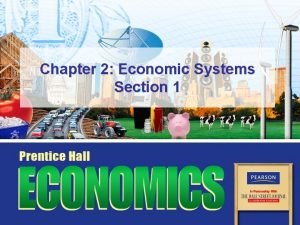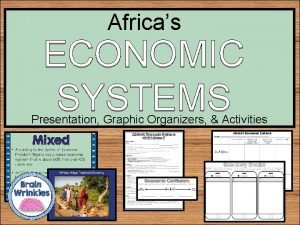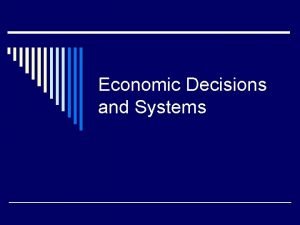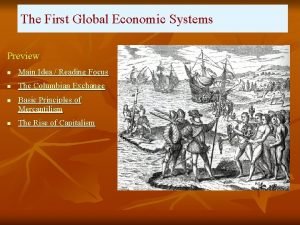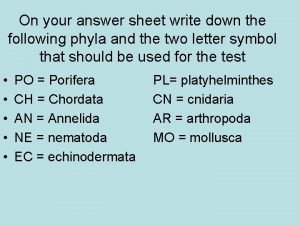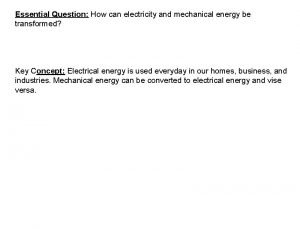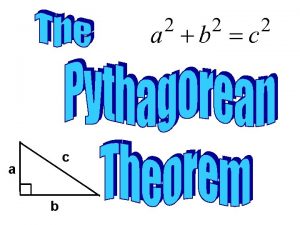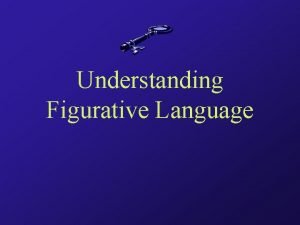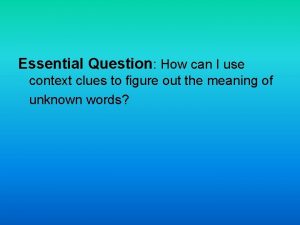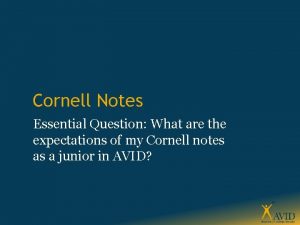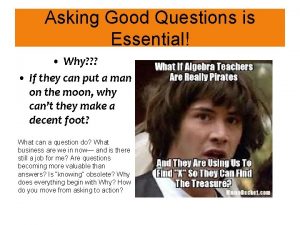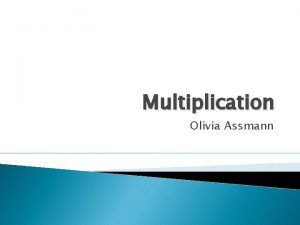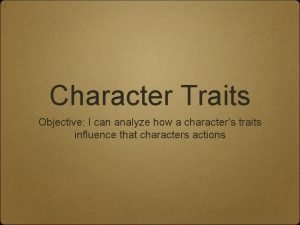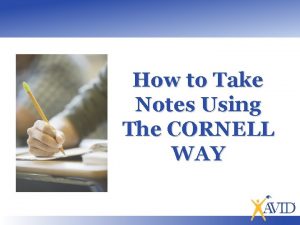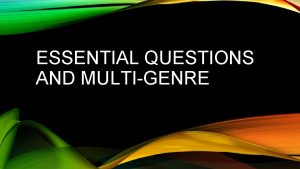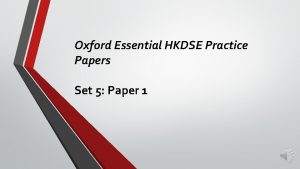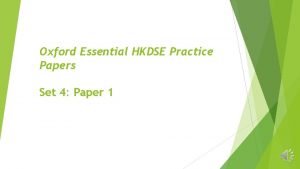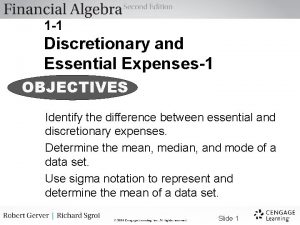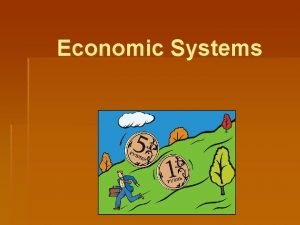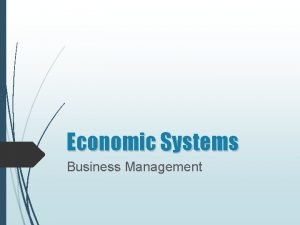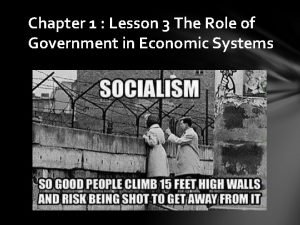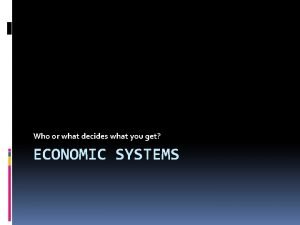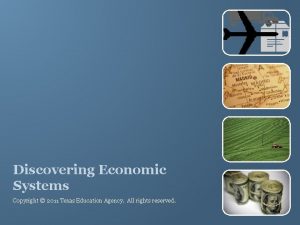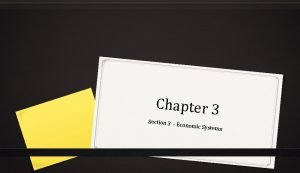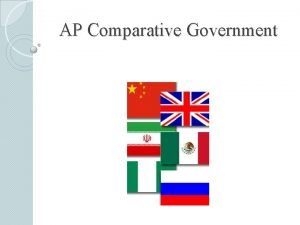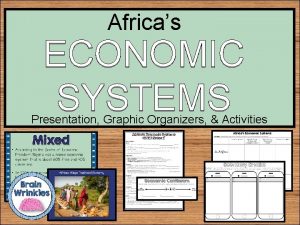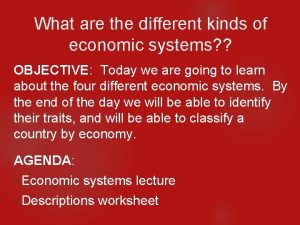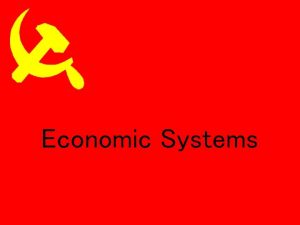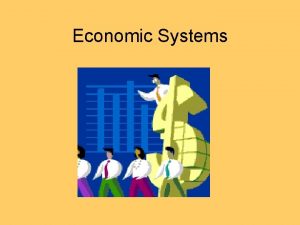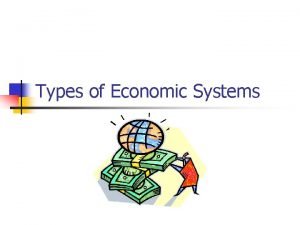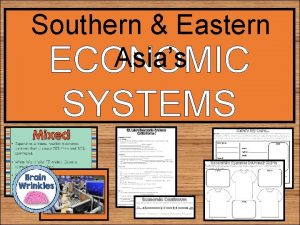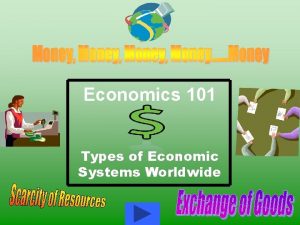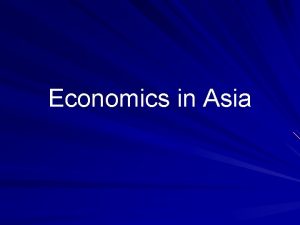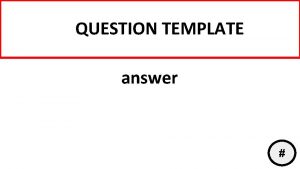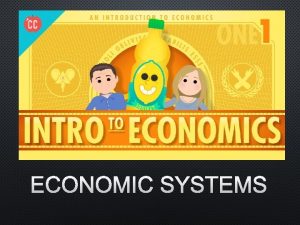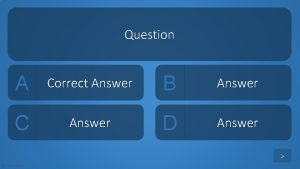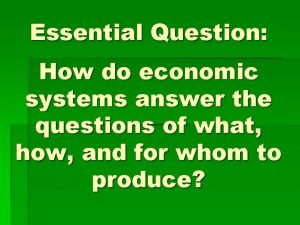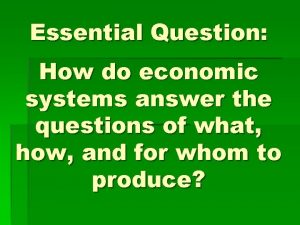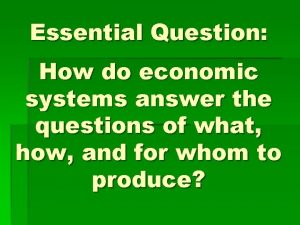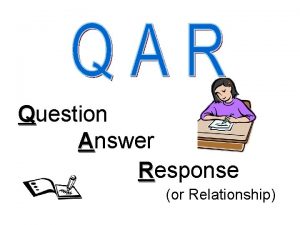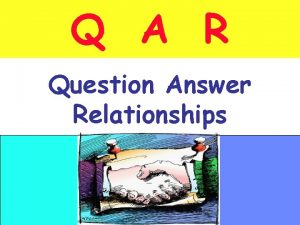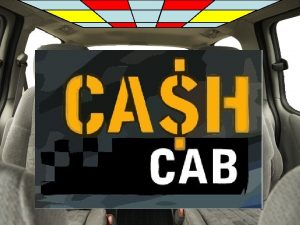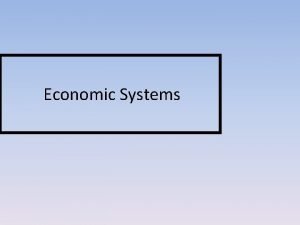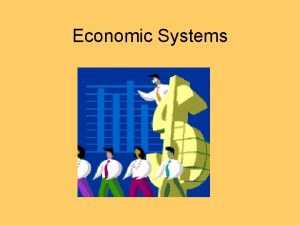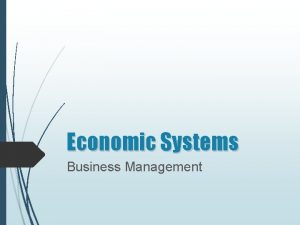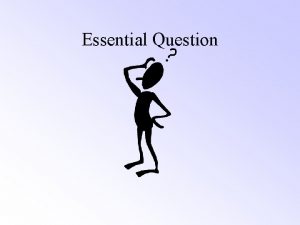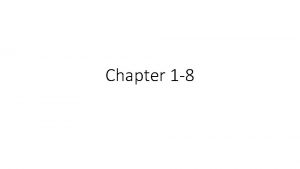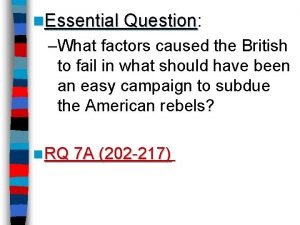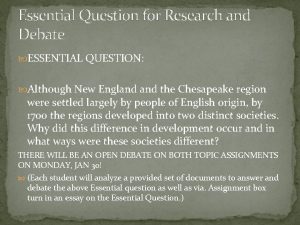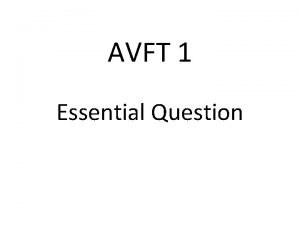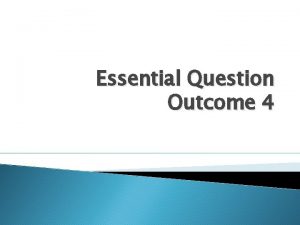Essential Question How do economic systems answer the



























































- Slides: 59

Essential Question: How do economic systems answer the questions of what, how, and for whom to produce?

Standards: § SS 7 E 1 a, SS 7 E 5 a, SS 7 E 8 a Compare how traditional, command, and market economies answer the economic questions of (1) what to produce, (2) how to produce, and (3) for whom to produce § SS 7 E 1 b, SS 7 E 5 b, SS 7 E 8 b Explain how most countries have a mixed economy located on a continuum between pure market and pure command.

Essential Questions § § What is economy? What is the purpose of currency in an economy? What factors influence economy? How do the traditional, command, and market economies of Southwest Asia countries answer the economic questions of (1) what to produce, (2) how to produce, and (3) for whom to produce? § Where are the economic systems of Southwest Asia located on a continuum between pure market and pure command?

Before we can discuss economic systems, we need to review the basic concepts of Economics. What is Economics?

Economics – the choices we make about how to use limited resources to produce goods & services that meet our unlimited wants & needs.

Hi! My name is Stan and today I am going to teach you about economics.

Yesterday, when I was walking through town, I decided to go to “Bubba’s Ice Cream”. My friend Diana works there. Diana provides a service to me because she serves me ice cream. A service is any kind of work performed for others. The ice cream is a good. A good is something you can feel, or any kind of merchandise. Bubba’s Ice Cream

Look at the pictures on the right. Which of these pictures show goods and which ones show services? 1) 2) 3) 4)

I’m sorry Stan! I asked Diana for a double scoop of my favorite kind of ice cream: mint chocolate chip. “I am sorry Stan, we are all out of that flavor”, she said. Disappointed, I settled for vanilla.

What is supply and demand? 100 90 80 70 Gallons 60 50 40 30 20 10 0 vanilla choc. straw. Flavors mint choc. The supply of mint chocolate chip ice cream at “Bubba’s” was gone because it was in high demand (wanted) by many customers. Look at the chart on the left to see what flavors are in supply at “Bubba’s Ice Cream”.

What is supply and demand? Supply is the amount of something available for use.

What is supply and demand? Demand is how much of a product or service is desired by buyers.

Diana asked me if I would like my vanilla ice cream in a cup or a cone. I asked for a cone. Diana said I was lucky because there was only one more cone available. The little boy behind me in line wailed, “I wanted my ice cream in a cone!” I told Diana that he could have the last cone, and that I would have mine in a dish with chocolate syrup.

There was a scarcity of cones at Bubba’s. Scarcity means that there are limited supply of something, and therefore, people must make choices. Look at the pictures on the right. Which pictures show a scarcity? 1) 2) 3)

After I finished my ice cream, I said goodbye to Diana and left. In the street I heard two children singing a song to the tune of “You Are My Sunshine”. It went like this: “We are consumers! We are so happy when we can shop! We are consuming goods and services, But our wants just will not stop!”

I found myself singing along to the tune. When we were finished singing I asked, “Where are you two going? ” The boy, whose name was Andy, answered: “We’ve saved up all our money and today we are going to the toy store! My sister Sara wants to buy either a rabbit or a bike and I want to buy either a basketball net or a skateboard”. Toy Store

What are producers and consumers? n n The two children in this example are consumers. A consumer is anyone who buys a good or a service. The toy store owner in this example is a producer. A producer is anyone who makes or grows a good or performs a service. Consumer

What is opportunity cost? n Andy had $65. 00 to spend at the toy store. The basketball net cost $50. 00, so he had to buy that instead of the skateboard, which cost $75. 00. n Sara had enough money for either the rabbit or the bike. She decided to buy the bike because then she could ride bikes with her friends after school.

Opportunity Costs Purchases Opportunity cost is the process of choosing one good or service over another. The item that you don’t pick is the opportunity cost. The rabbit is Sara’s opportunity cost and the skateboard is Andy’s opportunity cost.

What is a profit? What Andy didn’t realize when he bought his basketball net was that the toy store owner made a large profit off of the sale. The toy store owner spent $30. 00 to make the basketball net. Andy bought it for $50. 00. The toy store owner made a profit of $20. 00.

What is a profit? Profit is the positive gain from an investment or business after subtracting expenses (opposite of loss)

What is a loss? The toy store owner lost money when Sara purchased the bike. The owner made the bike for $80. 00, but sold it to Sara for only $65. 00. The toy store owner lost $15. 00.

What is a loss? A loss is when the amount of money a person or company spends is more than they receive or take in. (opposite of profit)

After the children left the toy store I decided to stay and have a look around. In the front of the store there was a magnificent toy car. “Wow”, I exclaimed, “What a neat car! Did you make it yourself? ” The toy store owner explained that it was designed by a car company, put together by Mattel, a toy company, and painted by himself. “Painting is my specialty”, he said.

What is specialization? The toy store owner counted on others to do the necessary work to construct the toys he sold, but then he would paint the toys himself. Specialization is when an individual or a company specializes in doing one part of a task, and relies on others to complete the other parts.

What is interdependence? Interdependence is when people depend on one another. Specialization results in interdependence.

Johnson Elementary School I said goodbye to the toy store owner and continued on my walk through town. I passed the elementary school as I rounded the corner. Public schools are services provided by the government and paid for by taxes.

What are taxes? n n n Taxes are the money that the government collects from individuals and businesses to pay for public goods and services. Andy and Sara both paid a 4. 5% sales tax when they bought their toys. Andy paid an extra $2. 25 in tax, for a total of $52. 25. Sara spent $2. 93 in sales tax for a total of $67. 93. People also pay an income tax. An income tax is a percentage of money taken out of your income.

I passed the school and saw my friend Cole walking down the street. “How are you today? ”, I asked Cole. “I am fantastic! I just thought of a new idea: a bowling ball that expands as you throw it so that it is guaranteed to knock down every pin! I am going to be famous!”

What is an entrepreneur? Cole is an entrepreneur. An entrepreneur is a person who comes up with a product or service, or a better way to produce one. He found the resources, the money, and the time to produce a new product.

Goodbye! This completes my lesson on economics! I hope you enjoyed the tour. Economics is an important part of our lives. Think of all of the ways you use economics everyday!

Economic Terms Review Matching Strips

What is Economics? Every society has productive resources: Land/ Natural Resources Human Capital/Labor Capital/Tools Entrepreneurship

What is Economics? Productive Resources are used to produce: Goods Services

What is Economics? However, because of SCARCITY, choices must be made to answer the Three Basic Questions of Economics. 1. What goods and services will be produced? 2. How will the goods and services be produced? 3. Who will consume the goods and services? 35

Economic Systems

Economic Systems A Country must decide how to distribute its resources to meet the needs of its people. How a country makes these decisions determines its type of economic system.

An Economic System is the way a society organizes the production, distribution, and consumption of goods and services.

Vocabulary Break In small groups, sort the pictures provided as examples of production, distribution, or consumption

Economic Systems There are 3 basic types of economic systems that have to answer three basic questions: (1) What to produce? (2) How to produce? (3) For Whom to produce?

Economic Systems § WHAT TO PRODUCE? (What kinds of goods and services should be produced? ) § HOW TO PRODUCE? (What productive resources are used to produce goods and services? ) § FOR WHOM TO PRODUCE? (Who gets to have the goods and services? § The way a society answers these questions determines its economic system.

Types of Economic Systems: 1. Traditional Economy 2. Command Economy 3. Market Economy

Follow teacher instructions to create your Economic Systems Foldable to use for note-taking

Traditional Economy § An economic system in which economic decisions are based on customs and beliefs § People will make what they always made & will do the same work their parents did § Exchange of goods is done through Bartering: trading without using money

Traditional Economy § Who decides what to produce? § People follow their customs and make only what is needed to take care of oneself § Who decides how to produce goods & services? § People grow & make things the same way that their ancestors did § For Whom are the goods & services produced for? § Self and trading purposes (people in the village who need them)

Traditional Economy § Examples: § Villages in Africa and South America; the Inuit tribes in Canada; the caste system in parts of rural India § Strengths: Predictable job and lifestyle § Weaknesses: Lack resources and limited production

Distributed Summarizing Draw an illustration in your foldable that represents a Traditional Economy.

Command Economy § Government makes all economic decisions & owns most of the property § Sometimes called communism § Examples: Cuba, former Soviet Union, North Korea § This system has not been very successful & more and more countries are abandoning it

Command Economy § Who decides what to produce? § Government makes all economic decisions § Who decides how to produce goods and services? § Government decides how to make goods/services § For Whom are the goods and services produced for? § Whoever the government decides to give them to

Command Economy § Strengths: people do not have to worry about employment, housing, education, and healthcare § Weaknesses: consumers own nothing, no choices/freedom, limited innovation by individuals

Distributed Summarizing Draw an illustration in your foldable that represents a Command Economy.

Market Economy § In a market economy, buyers and sellers answer the three economic questions § All resources are privately owned § Who decides what to produce? § Whatever the market demands that will produce a profit § Who decides how to produce goods and services? § Private producers (businesses) § For Whom are the goods and services produced for? § Consumers who demand the product and are willing to pay

Market Economy § Strengths: People can start their own businesses, more choice § Weaknesses: The desire for money may lead to poor quality of goods and services, business owners have to risk losing money

Distributed Summarizing: Draw an illustration in your foldable that represents a Market Economy.

Distributed Summarizing: Economic System Quotes

Mixed Economy § Market + Command = Mixed § There are no pure command or market economies. To some degree, all modern economies show characteristics of both systems and are often referred to as mixed economies. § Most economies are closer to one type of economic system than another § For example, businesses own resources and determine what and how to produce, but the Government regulates certain industries

Mixed Economy § Most democratic countries fall in this category (there are no truly pure Market or Command economies). § Examples: U. S. , Brazil, Mexico, Canada, UK, etc.

Continuum of Economies Mixed Pure Command Pure Market

Summarizing Strategy Economic Systems Continuum Activity
 Chapter 1 lesson 2 our economic choices worksheet answers
Chapter 1 lesson 2 our economic choices worksheet answers Costa questionnaire answers
Costa questionnaire answers Economic question answer
Economic question answer Education health and famine cloze notes
Education health and famine cloze notes Chapter 2 economic systems answer key
Chapter 2 economic systems answer key Africa's economic systems comprehension check
Africa's economic systems comprehension check Chapter 2 economic systems and decision making answer key
Chapter 2 economic systems and decision making answer key Chapter 2 economic systems and decision making answer key
Chapter 2 economic systems and decision making answer key Chapter 1 economic decisions and systems answer key
Chapter 1 economic decisions and systems answer key Comparative systems worksheet answer key
Comparative systems worksheet answer key The first global economic systems answer key
The first global economic systems answer key Characteristics of lipids
Characteristics of lipids Write down your answer
Write down your answer Now write in your notebook
Now write in your notebook Figurative language essential questions
Figurative language essential questions The pythagorean theorem
The pythagorean theorem Essential question generator
Essential question generator Essential questions for pythagorean theorem
Essential questions for pythagorean theorem Language
Language Essential question about identity
Essential question about identity Context clues essential questions
Context clues essential questions Cornell notes essential question
Cornell notes essential question Open ended questions examples
Open ended questions examples Essential questions for multiplication
Essential questions for multiplication Essential question gif
Essential question gif Essential question for character traits
Essential question for character traits The cornell way
The cornell way Essential questions for short stories
Essential questions for short stories Economic growth vs economic development
Economic growth vs economic development Economic growth and development
Economic growth and development Oxford essential hkdse practice papers answer
Oxford essential hkdse practice papers answer Set 4 paper 2f
Set 4 paper 2f 1-1 discretionary and essential expenses exercise answers
1-1 discretionary and essential expenses exercise answers What economic system is germany
What economic system is germany Pure command system
Pure command system How many economic systems are there
How many economic systems are there Mixed economy political cartoon
Mixed economy political cartoon Chapter 2 economic systems and decision making
Chapter 2 economic systems and decision making Lesson 3 the role of government in economic systems
Lesson 3 the role of government in economic systems Who or what decides what you get?
Who or what decides what you get? Topic 2 free enterprise and other economic systems
Topic 2 free enterprise and other economic systems Discovering economic systems comparative worksheet answers
Discovering economic systems comparative worksheet answers The three economic systems
The three economic systems Economic systems
Economic systems Africa's economic systems cloze notes 1
Africa's economic systems cloze notes 1 What are the different kinds of economic systems
What are the different kinds of economic systems Why do we have economic systems
Why do we have economic systems Disadvantage of planned economy
Disadvantage of planned economy Command economy
Command economy Se asian economies comprehension check answer key
Se asian economies comprehension check answer key Types of economic systems
Types of economic systems What do economic systems seek to do?
What do economic systems seek to do? Question word simple present
Question word simple present Clearinghouse probe
Clearinghouse probe Contoh open ended question
Contoh open ended question Factor-isolating questions example
Factor-isolating questions example Change the direct questions into indirect questions
Change the direct questions into indirect questions Example of a compelling question
Example of a compelling question Example of a compelling question
Example of a compelling question Hát kết hợp bộ gõ cơ thể
Hát kết hợp bộ gõ cơ thể




